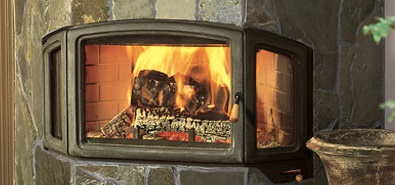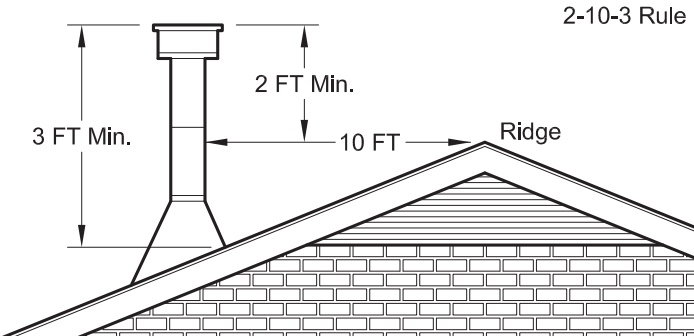Home Site Map - Techniques - Interior Infrastructure -
Wood Fire
![]() If you have access to wood then you can't beat the feel of a good
fire.
If you have access to wood then you can't beat the feel of a good
fire.

The wood burning fire I selected is here .
I like to be able to see the fire. I'm using two wood fires. One in the basement mudroom and one in the living room. In practice the workhorse will be the mudroom fire because it is better to handle the messy wood there. The hot air from there will be ducted to the main level living area. The wood fire in the living room will likely only get used on special occasions such as Christmas and Thanksgiving and a few other long winter nights.
Can either feed the heat exchanger with fresh air from the HRV or let it recirculate the air already in the room. Recirculation is my choice as it will make the room warmer. To avoid fan noise, put the fan remote in the basement ceiling.
Efficiency
All EPA-certified stoves run within the same band of overall efficiency (combustion and heat transfer) - about 70 percent plus or minus 10 percent.
Needs to be an "Advanced Combustion" wood fireplace, ie one that is a fire behind gasketed glass doors that does a secondary burn of the emitted gasses. The fire is fed with outside "burn" air and all fire exhaust goes out the chimney. Room air is blown in separately and then goes via a heat exchanger before being sent to the room as hot air. You can divert the hot air off to other parts of the house. You can place a heat pump in the warm output air and use it to make hot water.
It must be 2.0 gr/hr or less to be sold and installed in WA state.
Blaze King also said: "You should look for a non catalytic stove with an HHV efficiency rating of 65%-70%, any more efficient that in this range could result in poor performance. I might suggest you look for a very large firebox 3.5 cu. ft. or more.". If the fire is too efficient then the gasses in the chimney will be too cold by the time they get to the top of a 50 foot chimney.
There are two types of wood stoves: catalytic and non-catalytic stoves. I would advise anyone who is buying a new stove to choose a non-catalytic model, because catalytic stoves are fussy to operate. Catalytic stoves have another major disadvantage: their catalytic converters have a limited lifespan and are expensive to replace when they wear out.
Firewood
A cord is a volume of neatly stacked firewood measuring 128 cubic feet. The traditional way to stack a cord is to make the pile 8 feet long, 4 feet high, and 4 feet deep. If you are using 24-inch wood, such a cord is two stacks deep. If you are using 16-inch wood, such a cord is three stacks deep.
My choice is to standardize on 18" long wood (to easily fit into a 21" firebox). This means if stacking in two rows then the length of the wood rack should be 12'8" long (with a height of 4').
Chimney
When selecting a fire don't forget about the cost of the chimney. Small diameter chimneys are less expensive than large diameter.
You must use the chimney that is specified for the particular fire model you chose. It must be a stainless chimney for a wood burning fire.
The chimney needs to be high in order to meet the 2 foot 10 foot 3 foot rule. It must be at least 2 feet taller than any structure within 10 feet of it and also at least 3 feet higher than the point at which it penetrates the roof. In my case I need to have a joggle in the chimney to get it more than 10 feet from the edge of the cupola. My assumption is that the railings round the top of the roof do not count as being part of the roof height as they are permeable to wind, so that means the chimney only needs to be 2 foot higher than the top edge of the roof. In practice my chimney height is the same as the top of the railings.

Make sure the fire you chose is able to handle the long length of chimney that will be fitted to it.
The chimney may require guy wires to strengthen it from high winds.
(The maximum chimney height for the Delta2 fire is 40 feet which means it will not work for the mudroom. It is ok for the living room fire.)
The chimney flue should be the same size as the appliance flue collar. Chimneys that are over-sized for the appliance they serve are common, partly because people used to think that bigger is better, but bigger is not better when it comes to chimney sizing. A given volume of flue gas flows faster and has less time to lose heat in a small chimney flue than in a large one. In planning wood heating systems, experienced installers will sometimes choose a chimney that has a smaller inside diameter than the appliance flue collar. This is usually done when the chimney runs inside the house and is very tall. Chimneys that exceed 8 m (about 25 ft.) in height sometimes produce more draft than the appliance needs, so a smaller chimney can be used without any reduction in performance.
It is best to route the chimney inside the building enclosure as this avoids excessive cooling of the gasses in the chimney (reducing up-draft) and also inside it helps heat the house.
Fan noise
There will be a fan to drive the room air through the heat exchanger. You need to ensure there is absolutely no fan noise. Put the fan remote in the basement.
Wood
A cord is a volume of neatly stacked firewood measuring 128 cubic feet. The traditional way to stack a cord is to make the pile 8 feet long, 4 feet high, and 4 feet deep. If you are using 24-inch wood, such a cord is two stacks deep. If you are ordering 16-inch wood, such a cord is three stacks deep.



